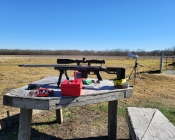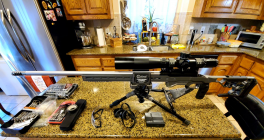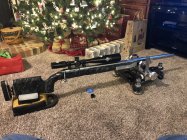What sample size is required to find OFPS?Correct. Whether you find OBT first, or OFPS first, if SD of MV shrinks (getting closer to OFPS), Dispersion would grow (getting away from OBT node) and vice versa. Thus, it is a compromise.
Install the app
How to install the app on iOS
Follow along with the video below to see how to install our site as a web app on your home screen.
Note: This feature may not be available in some browsers.
You are using an out of date browser. It may not display this or other websites correctly.
You should upgrade or use an alternative browser.
You should upgrade or use an alternative browser.
Vertical Dispersion: Flat spots on the MV ladder test are meaningless
- Thread starter Beiruty
- Start date
Here is an old load development for my Steyr SSG04 300WM rifle (hunting/intro sharpshooting rifle).Sounds like you have this figured out. Show us how all this turns out on the paper where we work from. Id love to see how it works in the real world
You can compare load 2, 3, 4. Note, that load 2 had smaller dispersion but high MV SD. Load 4 has very small MV SD, but the dispersion grew.
I had better examples, but I have to look for them.
I go with at least 5-shots so the MV SD would be meaningful. Also, 5-shots groups would give an indication for about the dispersion of the bullets.What sample size is required to find OFPS?
Dave,@Beiruty, what is your experience level. What have you won? There are some incredible shooters on this site (far better than myself by the way) offering you first hand results of performance; however, you just keep talking about Hornady’s 4DOF results. Sometimes listening to what others have to say with an open mind is the best way to improve your skillset.
Dave
As for the Hornady Ballistic Solver, it is just a tool.
You could use Berger Solver with their Radar based bullet profiles. The idea of that spreadsheet is to figure out what is the difference of 1% in MV at long range.
Thus, I selected 225gr ELDM launched at 3000 fps, compared to 3030 fps, what is delta dial up and what is the delta drop in inches.
You can use 230 LRHT Berger bullet and use the Berger online solver and repeat the exercise.
Last edited:
You are forgetting that you must have a rifle and reloading equipment that is more consistent. You are discussing and debating theory with people who, more than likely, have better equipment than you. And probably have far more experience than you under competition environments which ultimately is better than discussing this in a theoretical classroom environment.Dave,
As for the Hornady Ballistic Solver, it is just a tool.
You could use Berger Solver with their Radar based bullet profiles. The idea of that spreadsheet is to figure out what is the difference of 1% in MV at long range.
Thus, I selected 225gr ELDM launched at 3000 fps, compared to 3030 fps, what is delta dial up and what is the delta drop in inches.
You can use 230 LRHT Berger bullet and use the Berger online solver and repeat the exercise.
There is already a guy out there that has done the work that you are trying to “discover”. His name is Bryan Litz. You may have heard of him. His credentials are impeccable. He has a little company you may want to look into. His side gig is designing bullets for some hole in the wall company.
Anyhow, our guns and equipment are tuned to outperform any off the shelf fire arm over time.
To compare a factory gun (I’m referring to a top end gun manufacturer, (like ones you mentioned) is like comparing a dump truck to an F1 racing team.
We are firing 1,000’s of rounds in competition, load development and practice every year. And the goal for a lot of us is not the smallest group for a couple of shots but to maintain accuracy in many different conditions/locations over an entire day.
Our guns are scrutinized to the very smallest measurement. Our results and goals are vastly different than yours. We don’t just throw money at our guns to say look at this thing I have here at the local range. We do it to solve problems and win.
Again posting 3 to 5 shot groups doesn’t mean shit. Show me targets on paper at distance over 10 or 20 shots. And shooting steel is fun but from a statistical standpoint, isn’t as accurate as paper.
I like shooting steel as much as the next guy but that not how I compete.
Our ladder tests and seating depth tuning is the most effective and efficient way to tune competition guns for accuracy.
And finally. You my friend are barking up the wrong tree. Coming here starting this tread is a veiled attempt at starting a pissing match turned into a dumpster fire. I get it, you want to be entertained. But trying to discuss advanced mathematics and statistical theory in this environment is pointless.
The information you are after? You are trying to reinvent the wheel and it’s already been done. My recommendation to you (if you are genuine in your pursuit for knowledge) is to go buy Bryan Litzy’s books. Everything you claim to want to know is in there. You should take up you theories with Bryan or his staff directly not try to impress a bunch of shooters on a forum. He and his people attend PRS and ELR matches all the time. Find them in Facebook and schedule a time to hang out with them. I’ve done it. They are very helpful.
Last edited:
@Tarmacshooter,
I know Bryan Litz personally. I have all his books and I chat with him when there is time and need to do so.
I pre-ordered his latest book and I do recommend for each one to pre-order it too.
There is a big section of the new book Modern Advancements in Long range shooting, V3 about reloading, load development and the use of barrel tuners.
BTW, speaking of number of a series of 5-shots groups, how about this
I know Bryan Litz personally. I have all his books and I chat with him when there is time and need to do so.
I pre-ordered his latest book and I do recommend for each one to pre-order it too.
There is a big section of the new book Modern Advancements in Long range shooting, V3 about reloading, load development and the use of barrel tuners.
BTW, speaking of number of a series of 5-shots groups, how about this

Bryan Litz Ballistics
One thing you learn when you shoot a lot of groups is the wide range of group sizes that are normal. Many shooters seem to expect a gun to shoot basically the same group size all the time, but...
 www.facebook.com
www.facebook.com

Bryan Litz Ballistics
One thing you learn when you shoot a lot of groups is the wide range of group sizes that are normal. Many shooters seem to expect a gun to shoot basically the same group size all the time, but...
 www.facebook.com
www.facebook.com
I find his experience very similar to mine, that's why I say my rifle averages group xx/xx".@Tarmacshooter,
I know Bryan Litz personally. I have all his books and I chat with him when there is time and need to do so.
I pre-ordered his latest book and I do recommend for each one to pre-order it too.
There is a big section of the new book Modern Advancements in Long range shooting, V3 about reloading, load development and the use of barrel tuners.
BTW, speaking of number of a series of 5-shots groups, how about this

Bryan Litz Ballistics
One thing you learn when you shoot a lot of groups is the wide range of group sizes that are normal. Many shooters seem to expect a gun to shoot basically the same group size all the time, but...www.facebook.com
What are you using for testing?@Tarmacshooter,
I know Bryan Litz personally. I have all his books and I chat with him when there is time and need to do so.
I pre-ordered his latest book and I do recommend for each one to pre-order it too.
There is a big section of the new book Modern Advancements in Long range shooting, V3 about reloading, load development and the use of barrel tuners.
BTW, speaking of number of a series of 5-shots groups, how about this

Bryan Litz Ballistics
One thing you learn when you shoot a lot of groups is the wide range of group sizes that are normal. Many shooters seem to expect a gun to shoot basically the same group size all the time, but...www.facebook.com
If I remember correctly, you don’t have any of your own data.
So if you know Bryan personally, why are you here on this thread? Do you think any of us are statisticians who can shed light on your theory that you don’t any any personal data on?
About the only person who I would trust to chime in on this is Lou Merdica. He tests things in his tunnel. He does work that is second to none. A close runner up is Bart.
No I mean for the system. What loading equipment, rifle, scopes, etc. environmental conditions can induce error at distance. I know the old adage is, if it can’t shoot at 100 yds….. The sun by itself ducking in and out of clouds will cause errors.
What are you using for testing?
If I remember correctly, you don’t have any of your own data.
So if you know Bryan personally, why are you here on this thread? Do you think any of us are statisticians who can shed light on your theory that you don’t any any personal data on?
About the only person who I would trust to chime in on this is Lou Merdica. He tests things in his tunnel. He does work that is second to none. A close runner up is Bart.
I’m less restrictive I suppose in what I like to read here. To my thinking, cogent tuning theories (or questioning of theories) is a function of logical reasoning and isn’t dependent on a person’s positive match experience or gear quality. Calling 10’s and X’s at 1,000 is just too different a skill set than producing an accurate rifle for that job. You can possess both or just one skill.
We are seeing for example, that in Erik’s interviews, not only do winning shooters vary dramatically in load preparation and tuning, but if you “quote” them at different phases of their shooting careers, it’s like listening to different people, altogether. The conversation is always alive.
Bryan, since he is being discussed here, I glean, believes, without being overt about it, that we are sometimes given overthink and overdo load development, that our competition barrels are stiffer and less prone to meaningful harmonic uncertainties than we give them credit for, that a gun’s potential for accuracy can be flushed out pretty quickly and easily, and needs to be before it is worn out, and that the magnitude of the smallest incremental improvements won’t determine dropped points.
Last edited:
Here is one of my heavy rifles, a custom 6.5 PRC based on Savage SA, Large Shank action with 30" barrelNo I mean for the system. What loading equipment, rifle, scopes, etc. environmental conditions can induce error at distance. I know the old adage is, if it can’t shoot at 100 yds….. The sun by itself ducking in and out of clouds will cause errors.
The scope is Vortex Golden Eagle 15-60x52.
I do use front reset and rear bags too.
Here I was hooting at a private range 100-1100 yards

Last edited:
Here’s mine. I’ll bet my setup induces less error than yours. Adding the slightest extra shoulder or cheek pressure or “slapping the trigger” will cause a 1 moa errant shot. Go from a 10 ring to the 9 ring. Done it more than I can count.
Attachments
When Bryan was testing bullets, there were a lot of barrel nut / Savage action/type rifles being used. Many guys here, myself included, have used them, kept maybe one or two, and then spent more $, again and again. They are very capable of small groups.
Here’s mine. I’ll bet my setup induces less error than yours.
Santa brings guns? I need to move further North. By my house, it’s socks.
Rub and tugs gift certificates help with Santa.
Savage target actions are pretty capable. At the end of the day they will only get you so far. The trigger selection is terrible.When Bryan was testing bullets, there were a lot of barrel nut / Savage action/type rifles being used. Many guys here, myself included, have used them, kept maybe one or two, and then spent more $, again and again. They are very capable of small groups.
But almost nobody shoots a TA in competition and is successful on a national level.
Very beautiful rifle.Here’s mine. I’ll bet my setup induces less error than yours. Adding the slightest extra shoulder or cheek pressure or “slapping the trigger” will cause a 1 moa errant shot. Go from a 10 ring to the 9 ring. Done it more than I can count.
Thank you. It’s not good enough. Off to backup duty. Or my other son will shoot it. This rifle has had things documented on it here on this website.Very beautiful rifle.
Similar threads
- Replies
- 3
- Views
- 721
Upgrades & Donations
This Forum's expenses are primarily paid by member contributions. You can upgrade your Forum membership in seconds. Gold and Silver members get unlimited FREE classifieds for one year. Gold members can upload custom avatars.

Click Upgrade Membership Button ABOVE to get Gold or Silver Status.
You can also donate any amount, large or small, with the button below. Include your Forum Name in the PayPal Notes field.
To DONATE by CHECK, or make a recurring donation, CLICK HERE to learn how.

Click Upgrade Membership Button ABOVE to get Gold or Silver Status.
You can also donate any amount, large or small, with the button below. Include your Forum Name in the PayPal Notes field.
To DONATE by CHECK, or make a recurring donation, CLICK HERE to learn how.











